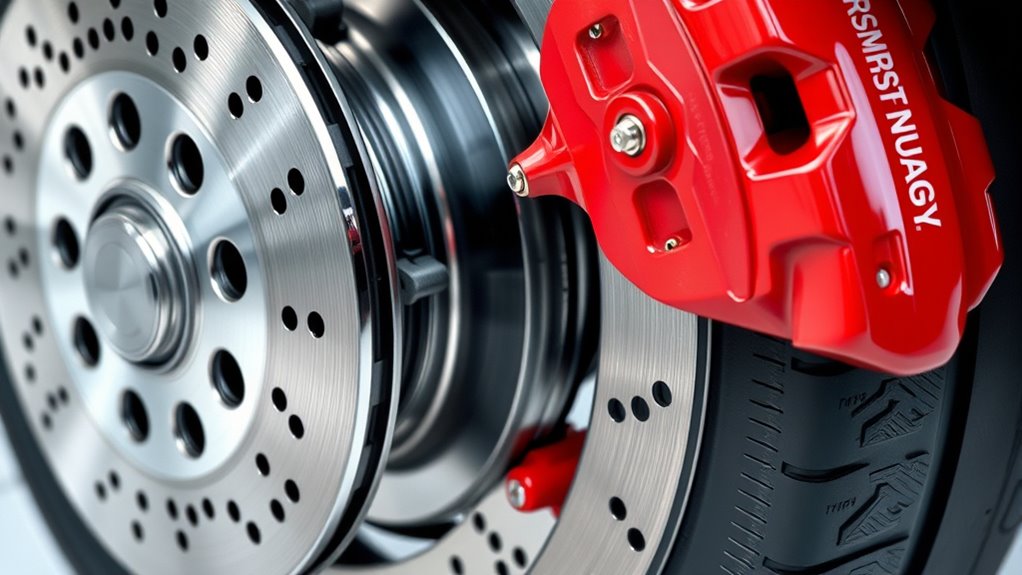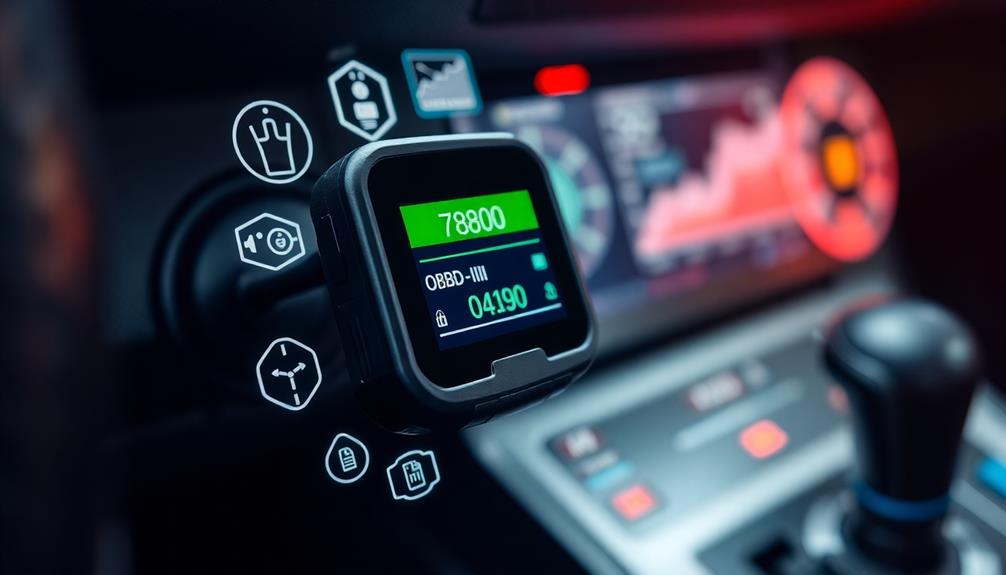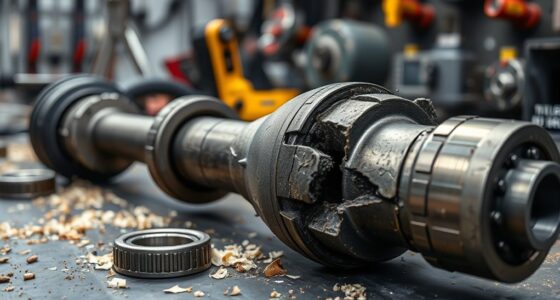Your vehicle’s brake system uses hydraulic pressure to keep you safe by converting pedal force into braking power. When you press the brake pedal, the master cylinder pushes brake fluid through lines to calipers or wheel cylinders, which then press brake pads against rotors or drums, slowing the wheels. Different pad materials affect performance and heat management. Understanding how these components work together helps guarantee safe stopping, and exploring further reveals how to maintain ideal brake function.
Key Takeaways
- The brake system converts pedal pressure into hydraulic force to slow or stop a vehicle.
- It comprises components like the brake pedal, master cylinder, brake lines, and calipers or wheel cylinders.
- Brake pads, made from various materials, create friction against rotors or drums to decelerate wheels.
- Proper heat management and material selection prevent brake fade and ensure consistent performance.
- Regular maintenance of hydraulic and friction components is essential for safety and optimal braking efficiency.

Have you ever wondered how your vehicle slows down or stops so reliably? It all comes down to the brake system, a complex network designed to convert your foot’s pressure into the force needed to bring your vehicle to a halt. At its core, the brake system relies on hydraulic pressure to transfer your input into effective braking force. When you press the brake pedal, you’re activating a master cylinder that pushes brake fluid through a series of brake lines. This pressurized fluid then travels to the brake calipers or wheel cylinders, depending on your vehicle’s design. The hydraulic pressure generated ensures that even a small amount of pedal effort results in significant braking force at the wheels, providing both efficiency and safety.
Your vehicle’s brake system uses hydraulic pressure to convert pedal effort into stopping power reliably.
The materials used in brake pads play a vital role in this process. Brake pad materials determine how effectively heat is managed, how much friction is produced, and how long the pads will last. Common materials include organic compounds, semi-metallic, and ceramic composites, each offering different balances of performance, durability, and noise levels. Organic brake pads are softer and quieter but wear out faster, while semi-metallic pads are more durable and provide better heat dissipation, which is essential during aggressive braking. Ceramic brake pads, on the other hand, offer a smooth, quiet operation and excellent heat resistance, making them a popular choice for everyday driving and high-performance vehicles alike. The choice of brake pad material influences the overall feel of your brakes, how quickly they respond, and their longevity.
When you apply the brakes, the brake pads are pressed against the brake rotors or drums, creating friction that slows the wheels down. The quality of the materials used in your brake pads directly impacts how much heat is generated and how well it’s dissipated. Excessive heat can lead to brake fade, where stopping power diminishes, so selecting the right brake pad material is key to maintaining consistent braking performance. Understanding the brake system components and their interaction helps ensure proper maintenance and optimal safety. The interaction between hydraulic pressure and brake pad materials is a finely tuned process, ensuring that your vehicle responds predictably and safely every time you step on the pedal.
In essence, your vehicle’s braking system is a sophisticated combination of hydraulic technology and carefully chosen materials designed to work seamlessly together. Hydraulic pressure amplifies your input into powerful stopping force, while brake pad materials ensure that this force is applied efficiently and reliably, even under demanding conditions. Understanding these components helps you appreciate the importance of regular maintenance and choosing quality parts to keep your brakes functioning at their best.
Frequently Asked Questions
How Often Should I Replace Brake Fluid?
You should replace your brake fluid every 2 to 3 years, regardless of the brake fluid types your vehicle uses. Check your owner’s manual for the exact brake fluid capacity and recommended schedule. Over time, brake fluid absorbs moisture, reducing its effectiveness. Regularly flushing and replacing it keeps your braking system functioning properly and helps prevent corrosion. Don’t wait for brake issues—timely fluid changes ensure safe, reliable stopping power.
What Are Signs of Brake System Failure?
If you notice a brake system warning light, it’s a clear sign something’s wrong. Pay attention to brake noise symptoms like squealing or grinding, which indicate worn brake pads or issues. You might also experience a soft or spongy brake pedal, increased stopping distance, or vibrations when braking. Address these signs promptly; ignoring them can lead to brake failure, compromising your safety on the road.
How Do I Choose the Right Brake Pads?
Did you know that choosing the right brake pads can improve your stopping distance by up to 20%? To pick the best, consider brake pad materials like ceramic, semi-metallic, or organic, based on your driving style. Also, look for brake pad wear indicators—they alert you when pads need replacing. Your choice affects braking performance and longevity, so select pads suited for your driving conditions and vehicle requirements.
Can Brake Systems Be Upgraded for Better Performance?
Yes, you can upgrade your brake system for better performance. Performance upgrades include installing high-performance brake pads, rotors, and calipers. Aftermarket options offer a range of enhancements, like increased stopping power and heat dissipation. You should consult with a professional to choose the best upgrades for your driving style and vehicle. Upgrading your brake system guarantees safer, more responsive braking during demanding conditions or spirited driving.
What Is the Average Lifespan of Brake Components?
You can expect brake components like brake pads to last around 30,000 to 70,000 miles, depending on your driving habits and brake pad wear. Rotors typically last longer, around 70,000 miles, but their lifespan can decrease with frequent heavy braking or poor maintenance. Regular inspections help you monitor rotor longevity and brake pad wear, ensuring your braking system stays safe and effective longer.
Conclusion
Think of your brake system as the captain of a ship, steering you safely through every journey. When you press the pedal, it’s like giving a command that tells your car to slow down and stop. By understanding how each part works together, you become the navigator of your vehicle’s safety. Keep your brake system well-maintained, and you’ll sail smoothly, knowing you have the power to stop whenever needed—like a captain confidently steering through calm or stormy seas.









